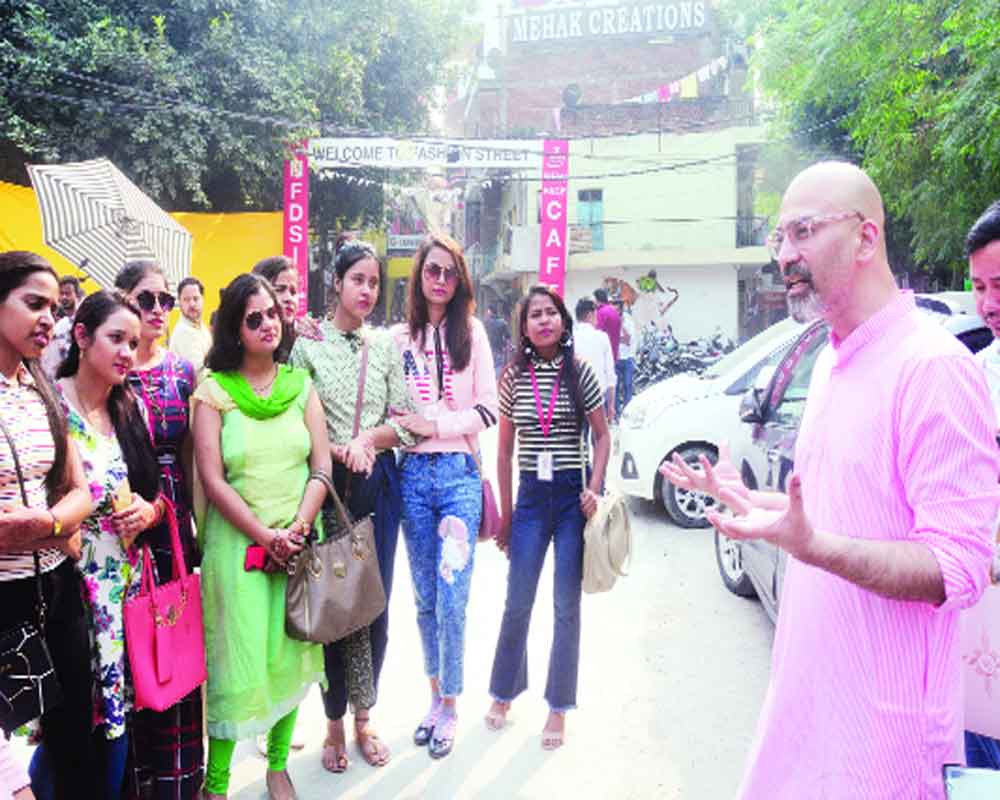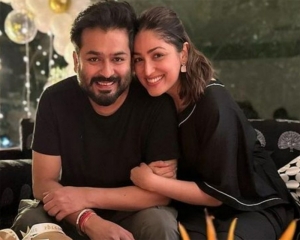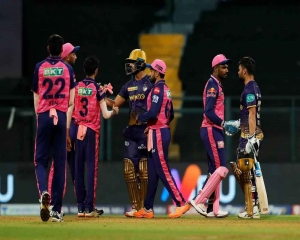Saimi Sattar explores Shahpur Jat, a designers’ hub, with Rishi Raj, to understand the different elements of history, accessibility and aesthetics that make it special
Step into a designer store at a fancy mall and there is an aura of intimidation that refuses to shrug itself off irrespective of how heavy a wallet you carry or whether you are shopping for a trousseau or a pret dress. Yes, a redux of the famous scene from the Julia Roberts- starrer Pretty Woman is bound to play in your head when you enter a high-end store. But stereotypes exist to mark out the disruptors in the game. Away from stiff upper lips, nose in the air and a condescending attitudes is Shahpur Jat, a hub, where it is as normal to bump into a crafts person as often as a designer. It is to explore this and more that Rishi Raj, a stylist who has dressed the likes of Kangana Ranaut and Katrina Kaif, besides ordinary mortals, undertook a walk on retail therapy in the fashion street, which was held as a part of the Shahpur Jat Autumn Festival by the Delhi Government.
“The best part about this place is that it democratises fashion,” says Raj as he addresses a motley group of about 25 women, many from a polytechnic in Ghaziabad, who have assembled at a meeting point on an afternoon. Before we dive into the throes of the action, Raj gives us a brief history of the area. “This was agricultural land, so a lot of Jat clans, the Panwars and the Tomars settled here and became fairly prosperous. Shahpur Jat means the royal land of the Jats,” he says. With time Khel Gaon, Asiad Village and Hauz Khas came up and rich wealthy families settled there. “Wherever the affluent section moves, luxury and fashion also make an appearance. So it developed as a fashion market,” he says. What makes the market special is that the two layers exist cheek by jowl, intersecting at times though not quite as many original inhabitants have rented out their properties to the new. “Often, when we climb the steps to visit a studio, we can see food being cooked in a kitchen or hear the whistle of a pressure cooker,” says Raj.
We start walking and Raj gestures towards two carts, one selling tender coconut water and the other, shakarkandi (sweet potato) chat. “This is sustenance,” announces Raj and adds, “When I am here, this is often what I survive on and you need to try this before you leave,” against the backdrop of shuffling feet as we move ahead. We are headed to Mint Blush, a store run by three young designers – Amir, Sahil and Shazmeen. We bump into Amir a little before his store, parked as he is with one foot resting on a scooter and at the end of his hand is dangling a cigarette. “This is exactly what I was saying. We can just bump into many of the designers and some have become friends. Unlike the top-notch ones with whom you have to take an appointment,” points out Raj and this statement is borne out thrice more during a period of two hours that we pace about in the narrow lanes which also house the likes of Samant Chauhan, Jenjum Gadi and Nida Mahmood.
Raj says that there is a reason why each level of fashion designers should co-exist. He adds, “Fashion started as a form of expression. Now it has become an association where your self-worth is defined by the brand that you wear.”
We troop into the small store and fit but just barely. The racks on display cater to both men and women with their interesting mix of lightweight lehengas, suits, bandhgalas, sherwanis and Indo-Western wear. Amir says, “This place holds everything that we need. There are embroiderers, dyers, printers, even people who can make the publicity material and what have you. So you can find textiles, heritage work, fashion pret, juttis, traditional batuas with intricate work so it is a one-stop market for everything. Plus, the rents are a fraction of any of the big designer malls. Naturally, for a new designer, this is the place to be in.” Raj nods in agreement and adds, “You are earning for yourself rather than for your landlord.”
Moreover, as a spin-off, modelling agencies are also beginning to sprout. “They are teaching and training people interested in the profession. There are designers in the areas so it is easy to get work.” We can see the board of one agency, Purple Thoughts, that can be approached after climbing a narrow stairway. Looking up, we see a mesh of electric wires, through which the sunlight streams through. It is as much a part of the collage of the area as a Samant Chauhan studio existing at a stone’s throw away from a small non-AC store peddling Telephone brand of threads which “don’t lose colour”.
“It is like an artisanal village with everything. When sourcing embellishments, it is not possible to go a place like Turkman Gate each time. Plus, at many of the shops, things are sold in wholesale which are unaffordable for the smaller designers. Not just the ornamentation but even the craftsperson to sew it on and stitch the clothes can be found in the area,” says Raj.
He also points out that designers here are closer to the idea of heritage textiles and designs and as if on cue a thela laden with printed textiles appears. Soon customers are milling around it trying to figure out what works best for them.
He recalls that when he started out as a stylist, there were just five people in the profession. “I joined Satya Paul and started to put together saris, blouses and jewellery for Mandira Bedi who was the brand ambassador,” says Raj who has been coming here for the past 15 years.
Shahpur Jat works for a stylist like Raj who works with celebrities of all levels. “When I want to dress a starlet, this is where I come because it works for both. It is easy for a Katrina or an Aishwarya to get access to a Louis Vuitton or a Rohit Bal. Younger celebrities need styling and the designers here are hungry for exposure. It works out for both,” he says.
One thing that we can’t help but notice is the gorgeous window displays that each of the stores have. Some play around with mannequins that have heads made of wires, while the others have frames with crochet work in white, creating an ethereal look while there are still others which have embellished it with flowers that look almost real.
We walk into Nitya Bajaj’s store which screams bling and glam. But what is interesting is that very many of the clothes have a children’s version as well. Raj says, “I often source clothes from her for TV shows as these are ideal for it.”
The next stop that Raj shepherd us to is Olivia Dar’s studio. The French lady is not in the store which is located on the first floor and has a precarious spiral staircase leading to it. There are interesting knick knacks — bracelets made of beads, earrings fashioned from ornamentation that is usually used on clothes and kurtis and dresses with embroidery that reminds one of the weaving that one usually sees on the Mekhla chadar. “What is it that spurs a foreigner to come and work here?” he throws a question and answers himself, “Clearly, she sees potential.”
But the best is yet to come — a store Second Floor Studio, which has a large space spread over two floors. Raj tells us that Puneet Jasuja, the man behind it gave up his high-paying job in the US at 36 as he wanted to work with Indian design and products. “He sources jewellery, home ware, textiles and more from various clusters and villages,” says Raj. Especially, fascinating are the earrings made of blow glass, their very own modernistic take on lights, which can be worn with Indian and Western wear.
Raj points out that unlike what people might think that the place is inhabited by designers who are yet to make it big, there are some who have come back to the area. “There is a far greater footfall and sales-wise, it works better for even the bigger designers,” he says.
We are nearing the end of the walk and he tells us that the entire area is in a big oval, which is a part of third oldest city of Delhi called, Siri. “There are parts of rocks, tombs and mosques here and several monuments as well. The interesting thing about Delhi is that there is so much history which is especially important in terms of fashion because to know where you are going, you need to be aware of where you are coming from. How fashion, silhouettes, textiles and culture evolved is a part of Delhi’s history as it is the textile and design capital,” he says and adds that the place has become a craft and food hub. “There is rustic authentic fare rather than a spaghetti bolognese or a teriyaki or a sushi bar,” he guffaws.
By this time we have reached Tohfe Wala Gumbad. Certainly, a one of a kind, both the monument and the stroll around the area.
Photo: Pankaj Kumar


























